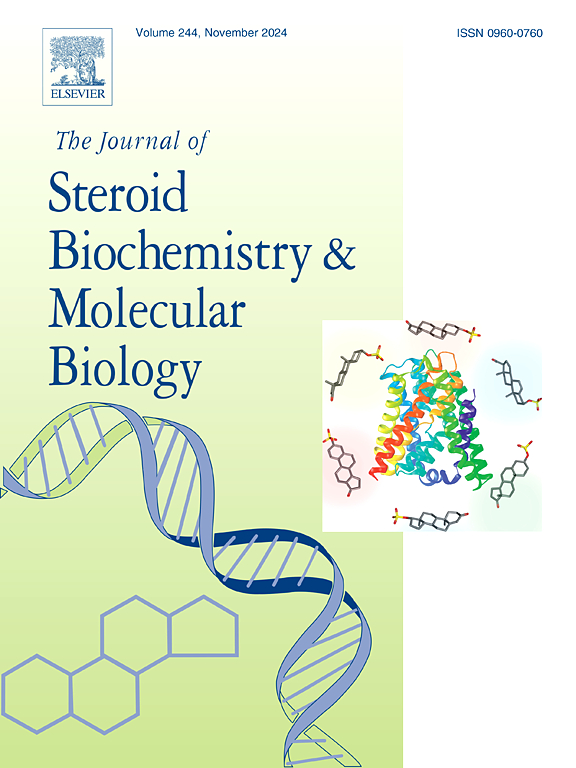5α-reductase type 3 is a predictive marker for chemotherapy efficacy in breast cancer in an androgen-independent manner
IF 2.5
2区 生物学
Q3 BIOCHEMISTRY & MOLECULAR BIOLOGY
Journal of Steroid Biochemistry and Molecular Biology
Pub Date : 2025-06-18
DOI:10.1016/j.jsbmb.2025.106818
引用次数: 0
Abstract
Breast cancer is one of the most representative sex-steroid-dependent cancers and both estrogens and androgens are locally synthesized in breast cancer tissues by sex-steroid producing enzymes. 5-reductase (5-Red) is an enzyme which reduces testosterone to biologically active dihydrotestosterone (DHT), serving as a regulator of intratumoral DHT levels. To date, three 5-Red isozymes have been identified: 5-Red types 1–3. However, 5-Red type 3 is not fully examined in breast cancer, and its contribution to DHT synthesis is yet to be elucidated. We therefore immunolocalized 5-Red type 3 in breast cancer tissues and correlated its immunoreactivity with intratumoral DHT levels as well as clinicopathological parameters. In the present study, 5-Red type 3 immunoreactivity was not correlated with intratumoral DHT level. Additionally, the immunoreactivity of 5-Red type 3 was negatively correlated with that of 17-hydroxysteroid dehydrogenase type 5, which converts androstenedione to testosterone. In the prognostic analysis, although 5-Red type 3 immunoreactivity was not correlated with patients’ clinical outcomes in the entire cohort of 172 breast cancer cases, it was significantly correlated with better clinical outcomes in the patients with non-luminal A type breast cancer or in those who received chemotherapy. These findings suggest that 5-Red type 3 does not contribute to intratumoral DHT synthesis, while served as a potent predictive marker for efficacy of chemotherapy in breast cancer independent of androgen action.
5α-还原酶3型是乳腺癌化疗疗效的一个不依赖于雄激素的预测指标。
乳腺癌是最具代表性的性类固醇依赖性癌症之一,雌激素和雄激素都是由性类固醇产生酶在乳腺癌组织中局部合成的。5α-还原酶(5α-Red)是一种将睾酮还原为具有生物活性的二氢睾酮(DHT)的酶,可调节肿瘤内DHT水平。迄今为止,已鉴定出3种5α-Red同工酶:5α-Red 1-3型。然而,5α-Red 3型在乳腺癌中尚未得到充分的研究,其对DHT合成的贡献尚不清楚。因此,我们在乳腺癌组织中免疫定位了5α-红3型,并将其免疫反应性与肿瘤内DHT水平以及临床病理参数相关联。在本研究中,5α-红3型免疫反应性与肿瘤内DHT水平无关。此外,5α-红3型与17β-羟类固醇脱氢酶5型的免疫反应性呈负相关,该酶可将雄烯二酮转化为睾酮。在预后分析中,虽然在172例乳腺癌患者的整个队列中,5α-红3型免疫反应性与患者的临床结局没有相关性,但在非腔内A型乳腺癌患者或接受化疗的患者中,5α-红3型免疫反应性与较好的临床结局有显著相关性。这些发现表明,5α-红3型不参与肿瘤内DHT的合成,但作为独立于雄激素作用的乳腺癌化疗疗效的有效预测指标。
本文章由计算机程序翻译,如有差异,请以英文原文为准。
求助全文
约1分钟内获得全文
求助全文
来源期刊
CiteScore
8.60
自引率
2.40%
发文量
113
审稿时长
46 days
期刊介绍:
The Journal of Steroid Biochemistry and Molecular Biology is devoted to new experimental and theoretical developments in areas related to steroids including vitamin D, lipids and their metabolomics. The Journal publishes a variety of contributions, including original articles, general and focused reviews, and rapid communications (brief articles of particular interest and clear novelty). Selected cutting-edge topics will be addressed in Special Issues managed by Guest Editors. Special Issues will contain both commissioned reviews and original research papers to provide comprehensive coverage of specific topics, and all submissions will undergo rigorous peer-review prior to publication.

 求助内容:
求助内容: 应助结果提醒方式:
应助结果提醒方式:


